Identification and Analysis of Ecological Corridors in the Central Urban Area of Xuchang Based on Multi-Source Geospatial Data
Abstract
:1. Introduction
2. Related Work
2.1. Urban Planning and Construction of Park Cities
2.2. Identification and Analysis of Ecological Networks and Corridors
2.3. Urban Network Analysis Research Based on Geospatial Big Data
2.4. Multi-Scenario Sentiment Analysis Research Based on Internet Comment Data
3. Research Area Overview
4. Methodology
4.1. Data Sources
4.2. Data Processing and Analysis Methods
4.2.1. Analytic Hierarchy Process
4.2.2. MCR Model
4.2.3. Gravity Model
4.2.4. NLP Sentiment Analysis
4.3. Ecological Corridor Identification Experiment
4.3.1. Data Preprocessing
4.3.2. Production–Living–Ecological Space Identification and Ecological Patch Generation
4.3.3. Ecological Resistance Surface Identification
4.3.4. Ecological Space Corridor Identification
4.3.5. Screening of Ecological Corridors Based on the Gravity Model
5. Analysis of Results
5.1. Statistics and Analysis of the Identification Results of Ecological Space Corridors in the Central City Area of Xuchang City
5.2. Analysis of Urban Parks Based on the Word-of-Mouth Score Data from Dianping
5.2.1. Analysis of Kernel Density of the Distribution of Green Parks in the Central City of Xuchang
5.2.2. Analysis of Kernel Density Based on the Distribution of Word-of-Mouth Score Data from Dianping on Green Parks in the Central City of Xuchang
5.2.3. Grade Distribution Analysis of Park Centers in Xuchang City
5.3. Sentiment Analysis of Urban Parks Based on Dianping Review Data
5.3.1. Build a Thesaurus of Perceptual Elements
5.3.2. Text Segmentation and Emotion Classification
6. Discussion
6.1. Central City Geospatial Optimization
6.2. Construction of Key Ecological Points in the Central Urban Area
6.3. Extend the Supply of Ecological Space
7. Conclusions
Author Contributions
Funding
Data Availability Statement
Acknowledgments
Conflicts of Interest
References
- Ignatieva, M.; Stewart, G.H.; Meurk, C. Planning and design of ecological networks in urban areas. Landsc. Ecol. Eng. 2011, 7, 17–25. [Google Scholar] [CrossRef]
- Jenkins, J.; Fleenor, A.; Dietz, F. Moving Beyond the Frame: Geovisualization of Landscape Change Along the Southwestern Edge of Yosemite National Park. J. Geovis. Spat. Anal. 2019, 3, 9. [Google Scholar] [CrossRef]
- Rinaldo, A.; Gatto, M.; Rodriguez-Iturbe, I. River networks as ecological corridors: A coherent ecohydrological perspective. Adv. Water Resour. 2018, 112, 27–58. [Google Scholar] [CrossRef] [PubMed]
- Zhou, Y.; Chen, M.; Li, B.; Li, M.; Yu, J.; Chen, J. Optimization of urban green space ecological network based on dynamic changes in spatial connectivity. J. Chin. Urban For. 2023, 21, 23–32. [Google Scholar] [CrossRef]
- Zang, T.; Li, X.; Zhang, L. Ecological civilization thought evolution process from urban green space system to urban ecosystem—Taking Shanghai as an example. Landsc. Archit. Acad. J. 2021, 38, 25–30. [Google Scholar] [CrossRef]
- Wang, W.; Liu, C.; Chen, Y.; Zhang, Y. Core meaning and scientific path of the concept of open sharing of urban park green spaces under the goal of park city. Landsc. Arch. 2023, 30, 28–34. [Google Scholar] [CrossRef]
- Jiang, H.; Hou, L.; Liu, S. Research on the planning and construction of the park city in Guangming district, Shenzhen. Guangdong Landsc. 2019, 41, 46–50. [Google Scholar] [CrossRef]
- Wei, W. Research on the construction of urban ecological network system based on territorial spatial planning. Intell. Build. Smart City 2023, 07, 39–41. [Google Scholar] [CrossRef]
- Li, N.; Wu, K. Research on the identification and distribution characteristics of urban functional zones based on POI data. Remote Sens. Technol. Appl. 2022, 37, 1482–1491. [Google Scholar] [CrossRef]
- Zhan, M.; Zhu, J. Research on the identification and spatial layout optimization of ecological space corridors in mega-cities based on POI data: A case study of Shenyang’s central urban area. Chin. Gardens 2021, 37, 112–117. [Google Scholar] [CrossRef]
- Hao, M.; Liu, D. Ecological network construction based on interest point recognition of habitat risk: A case study of Wuhan metropolitan area. Chin. J. Appl. Ecol. 2023, 34, 2471–2480. [Google Scholar] [CrossRef]
- Zheng, T.; Yan, Y.; Zhang, W.; Zhu, J.; Wang, C.; Rong, Y.; Lu, H. Landsense assessment on urban parks using social media data. Acta Ecol. Sin. 2022, 42, 561–568. [Google Scholar] [CrossRef]
- Xu, X.; Wang, S.; Rong, W. Construction of ecological network in Suzhou based on the PLUS and MSPA models. Ecol. Indic. 2023, 154, 110740. [Google Scholar] [CrossRef]
- Tandarić, N.; Ives, C.D.; Watkins, C. From city in the park to “greenery in plant pots”: The influence of socialist and post-socialist planning on opportunities for cultural ecosystem services. Land Use Policy 2022, 120, 106309. [Google Scholar] [CrossRef]
- Li, J.; Tang, B. Requirements for urban park construction under the concept of “park city”. Urban Des. 2023, 08, 6–13. [Google Scholar]
- Semenzato, P.; Costa, A.; Campagnaro, T. Accessibility to urban parks: Comparing GIS based measures in the city of Padova (Italy). Urban For. Urban Green. 2023, 82, 127896. [Google Scholar] [CrossRef]
- Huang, B.X.; Chiou, S.C.; Li, W.Y. Landscape pattern and ecological network structure in urban green space planning: A case study of Fuzhou city. Land 2021, 10, 769. [Google Scholar] [CrossRef]
- Ríos-Alvear, G.; Meneses, P.; Ortega-Andrade, H.M.; Santos, C.; Muzo, A.E.; Opez, K.G.L.; Bentley, A.G.; Villamarín, F. Key connectivity areas in the Llanganates-Sangay Ecological Corridor in Ecuador: A participative multicriteria analysis based on a landscape species. Landsc. Urban Plan. 2024, 246, 105039. [Google Scholar] [CrossRef]
- Peng, J.; Zhao, H.; Liu, Y. Urban ecological corridors construction: A review. Acta Ecol Sin. 2017, 37, 23–30. [Google Scholar] [CrossRef]
- Wu, Z.; Zhang, K.; Wang, H. Research on the construction and optimization of green space ecological network under urban expansion scenario simulation: Taking some areas in Nanjing as an example. Chin. Gard. 2022, 38, 56–61. [Google Scholar] [CrossRef]
- Zhang, D.; Ren, H.; Sun, P.; Jing, P.; Guo, B. Construction of multi-level ecological security network in fragmented nature landscape using the three-dimensional framework of ecological adaptability. Ecol. Indic. 2023, 157, 111229. [Google Scholar] [CrossRef]
- Lumia, G.; Pratico, S.; Di Fazio, S.; Cushman, S.; Modica, G. Combined use of urban Atlas and Corine land cover datasets for the implementation of an ecological network using graph theory within a multi-species approach. Ecol. Indic. 2023, 148, 110150. [Google Scholar] [CrossRef]
- Wang, N.; Zhao, Y. Construction of an ecological security pattern in Jiangnan water network area based on an integrated Approach: A case study of Gaochun, Nanjing. Ecol. Indic. 2024, 158, 111314. [Google Scholar] [CrossRef]
- Kirsch, K.; Newman, G.; Zhu, R.; McDonald, T.; Xu, X.; Horney, J. Applying and Integrating Urban Contamination Factors into Community Garden Siting. J. Geovis. Spat. Anal. 2022, 6, 33. [Google Scholar] [CrossRef]
- Zhao, J.; Sun, G.; Webster, C. Global street experiment: A geospatial database of pandemic-induced street transitions. Landsc. Urban Plan. 2024, 242, 104931. [Google Scholar] [CrossRef]
- Zhang, L.; Li, Y.; Li, C. Functional identification and spatial autocorrelation analysis of production-living-ecological space in Chengdu based on POl data. J. Green Sci. Technol. 2023, 25, 216–220. [Google Scholar] [CrossRef]
- Cao, G.; Gu, C.; Zhang, Q. Identification and pattern analysis of “three-dimensional living space” in central urban areas based on POI data: A case study of Shanghai’s central urban area. J. Urban Plan. 2019, 02, 44–53. [Google Scholar] [CrossRef]
- Su, C.; Hu, X.; Meng, Q.; Zhang, L.; Shi, W.; Zhao, M. A multimodal fusion framework for urban scene understanding and functional identification using geospatial data. Int. J. Appl. Earth Obs. Geoinf. 2024, 127, 103696. [Google Scholar] [CrossRef]
- Li, X.; Yue, J.; Wang, S.; Luo, Y.; Su, C.; Zhou, J.; Xu, D.; Lu, H. Development of Geographic Information System Architecture Feature Analysis and Evolution Trend Research. Sustainability 2024, 16, 137. [Google Scholar] [CrossRef]
- Nygren, O.; Calle, M.; Gonzales-Inca, C.; Kasvi, E.; Käyhkö, N. Automated geovisualization of flood disaster impacts in the global South cities with open geospatial data sets and ICEYE SAR flood data. Int. J. Disaster Risk Reduct. 2024, 103, 104319. [Google Scholar] [CrossRef]
- Foroutan, E.; Hu, T.; Zhang, F.; Yu, H. Assessing heat vulnerability in Philadelphia using geographically weighted principal component analysis (GWPCA): A geospatial big data-driven approach. Int. J. Appl. Earth Obs. Geoinf. 2024, 127, 103653. [Google Scholar] [CrossRef]
- Peixoto, J.P.J.; Bittencourt, J.C.N.; Jesus, T.C.; Costa, D.G.; Portugal, P.; Vasques, F. Exploiting geospatial data of connectivity and urban infrastructure for efficient positioning of emergency detection units in smart cities. Comput. Environ. Urban Syst. 2024, 107, 102054. [Google Scholar] [CrossRef]
- Zhong, E. Deep Mapping—A Critical Engagement of Cartography with Neuroscience. Geomat. Inf. Sci. Wuhan Univ. 2022, 47, 1988–2002. [Google Scholar] [CrossRef]
- Zhang, Y.; Wang, S.; Liang, H.; Li, X.; Wang, Z.; Lu, H. Dual hybrid frameworks combining graph convolutional network with decoding for covering location problem. iScience 2024, 27, 109803. [Google Scholar] [CrossRef]
- Zhong, Y.; Wang, S.; Liang, H.; Wang, Z.; Zhang, X.; Chen, X.; Su, C. ReCovNet: Reinforcement learning with covering information for solving maximal coverage billboards location problem. Int. J. Appl. Earth Obs. Geoinf. 2024, 128, 103710. [Google Scholar] [CrossRef]
- Liang, H.; Wang, S.; Li, H.; Zhou, L.; Chen, H.; Zhang, X.; Chen, X. Sponet: Solve spatial optimization problem using deep reinforcement learning for urban spatial decision analysis. Int. J. Digit. Earth 2024, 17, 2299211. [Google Scholar] [CrossRef]
- Lee, S.Y.M.; Lau, H.Y.P. An event-comment social media corpus for implicit emotion analysis. In Proceedings of the Twelfth Language Resources and Evaluation Conference, Marseille, France, 11–16 May 2020; pp. 1633–1642. Available online: https://aclanthology.org/2020.lrec-1.203.pdf (accessed on 1 July 2024).
- Hosgurmath, S.; Petli, V.; Jalihal, V.K. An omicron variant tweeter sentiment analysis using NLP technique. Glob. Transit. Proc. 2022, 3, 215–219. [Google Scholar] [CrossRef]
- Strąk, T.; Tuszyński, M. NLP Based Retrieval of Semantically Similar Private Tax Rulings. Procedia Comput. Sci. 2022, 207, 2853–2864. [Google Scholar] [CrossRef]
- Chen, Q.; Wang, W.; Huang, K.; Coenen, F. Zero-shot text classification via knowledge graph embedding for social media data. IEEE Internet Things J. 2021, 9, 9205–9213. [Google Scholar] [CrossRef]
- Chmiel, A.; Sienkiewicz, J.; Thelwall, M.; Paltoglou, G.; Buckley, K.; Kappas, A.; Hołyst, J.A. Collective emotions online and their influence on community life. PLoS ONE 2011, 6, e22207. [Google Scholar] [CrossRef]
- Marulli, F.; Verde, L.; Campanile, L. Exploring data and model poisoning attacks to deep learning-based NLP systems. Procedia Comput. Sci. 2021, 192, 3570–3579. [Google Scholar] [CrossRef]
- Lu, Z.; He, R.; Li, J. Research on Online comment negative emotion warning based on machine learning from the perspective of big data. In Proceedings of the 2019 International Conference on Computer Science, Communications and Multimedia Engineering, Shanghai, China, 22–23 September 2019; p. 6. [Google Scholar]
- Banerjee, T.J. A system of content analysis of social media using AI and NLP. Int. J. Res. Eng. Sci. Manag. 2021, 4, 132–136. Available online: https://journal.ijresm.com/index.php/ijresm/article/view/844 (accessed on 1 July 2024).
- Yan, H.; Zhang, L.; Du, P.; Liu, T.; Wang, Z.; Yang, W. Maps in the era of We-Media: Micro-maps. J. Geomat. Sei. Technol. 2016, 33, 520–523. [Google Scholar] [CrossRef]
- Gong, P.; Chen, B.; Li, X.; Liu, H.; Wang, J.; Bai, Y.; Chen, J.; Chen, X.; Fang, L.; Feng, S.; et al. Mapping essential urban land use categories in China (EULUC-China): Preliminary results for 2018. Sci. Bull. 2020, 65, 182–187. [Google Scholar] [CrossRef]
- Nikhil, S.; Danumah, J.H.; Saha, S.; Prasad, M.K.; Rajaneesh, A.; Mammen, P.C.; Ajin, R.S.; Kuriakose, S.L. Correction to: Application of GIS and AHP Method in Forest Fire Risk Zone Mapping: A Study of the Parambikulam Tiger Reserve, Kerala, India. J. Geovis. Spat. Anal. 2021, 5, 14. [Google Scholar] [CrossRef]
- Li, Z.; Ding, Y.; Wang, Y.; Chen, J.; Wu, F. Construction of ecological security pattern in mountain rocky desertification areas based on the minimum cumulative resistance model: A case study in Nanchuan District, Chongqing. J. Ecol. Rural Environ. 2020, 36, 1046–1054. [Google Scholar] [CrossRef]
- Hur, A.; Janjua, N.; Ahmed, M. Unifying context with labeled property graph: A pipeline-based system for comprehensive text representation in NLP. Expert Syst. Appl. 2024, 239, 122269. [Google Scholar] [CrossRef]
- Wang, S.; Lu, H.; Huang, Q.; Liang, Q. Analysis of road network characteristics based on SuperMap GIS. Geomat. Spat. Inf. Technol. 2013, 36, 109–112. [Google Scholar] [CrossRef]
- Hecht, R.; Behnisch, M.; Herold, H. Innovative approaches, tools and visualization techniques for analysing land use structures and dynamics of cities and regions. J. Geovis. Spat. Anal. 2020, 4, 19. [Google Scholar] [CrossRef]
- Liu, G.; Cao, M.; Li, Y. Data integration method for land spatial basic information platform based on SuperMap. Surv. Mapp. Geol. Miner. Resour. 2022, 38, 57–59. [Google Scholar] [CrossRef]
- Wan, J.; Fei, T. “Production-living-ecological spaces” recognition methods based on street view images. J. Geo-Inform. Sci. 2023, 25, 838–851. [Google Scholar] [CrossRef]
- Gong, H.; Chang, J.; Du, Y. Construction of county-level ecological network based on MCR and gravity model. Mapp. Bull. 2023, 81, 23–29. [Google Scholar] [CrossRef]
- Yao, C.; He, Y.; Cheng, J.; Zhang, T.; Ma, H.; Pan, H. Evaluation and optimization of ecological security pattern in the Minjiang River Basin based on minimum cumulative resistance model and gravity model. Acta Ecol Sin. 2023, 43, 7083–7096. [Google Scholar] [CrossRef]
- Yao, Q.; Gong, T.; Shi, J. Coupling development of urban rail transit and commercial facilities based on data from Dianping—Taking Tianjin as an example. J. Tianjin Chengjian Univ. 2019, 25, 239–245. [Google Scholar] [CrossRef]
- Cai, W.; Wang, S.; Zhong, E.; Feng, Z.; Li, M.; Wang, B. BIM and SuperMap GIS data integration technology. Geomat. World 2018, 25, 120–124. [Google Scholar] [CrossRef]
- Qin, X.; Zhen, F.; Zhu, S.; Xi, G. Research on the spatial distribution pattern of the catering industry in Nanjing city based on online reputation: Taking Dianping.com as an example. Sci. Geogr Sin. 2014, 34, 810–817. [Google Scholar] [CrossRef]
- You, T.; Wu, T.; Li, C.; Gao, F.; Wang, L. Exploring the symbiosis between ecological corridors and urban development based on habitat characteristics: Taking the construction of ecological corridors in the eastern region of Chengdu as an example. Environ. Sci. Manag. 2022, 47, 153–158. [Google Scholar] [CrossRef]

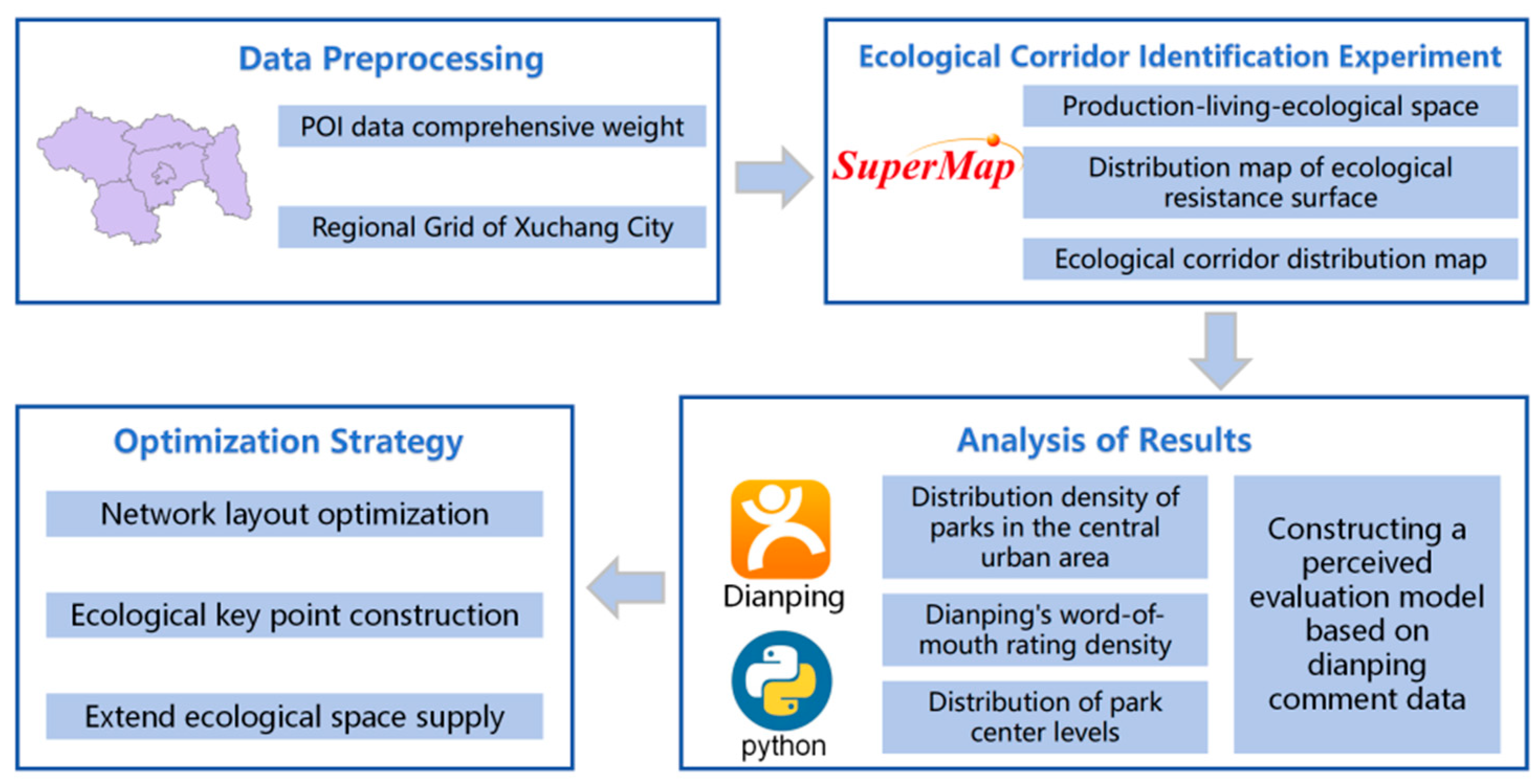
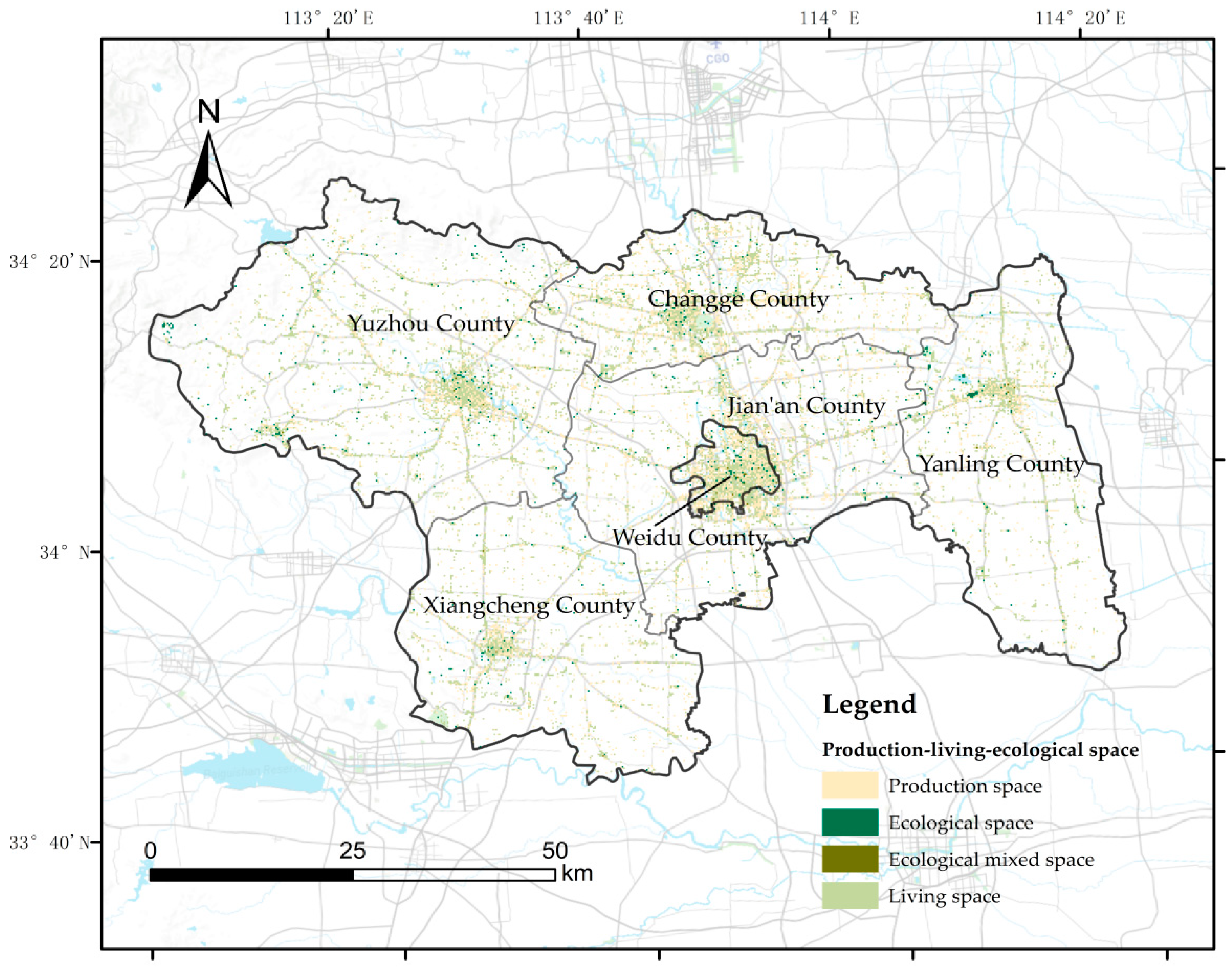
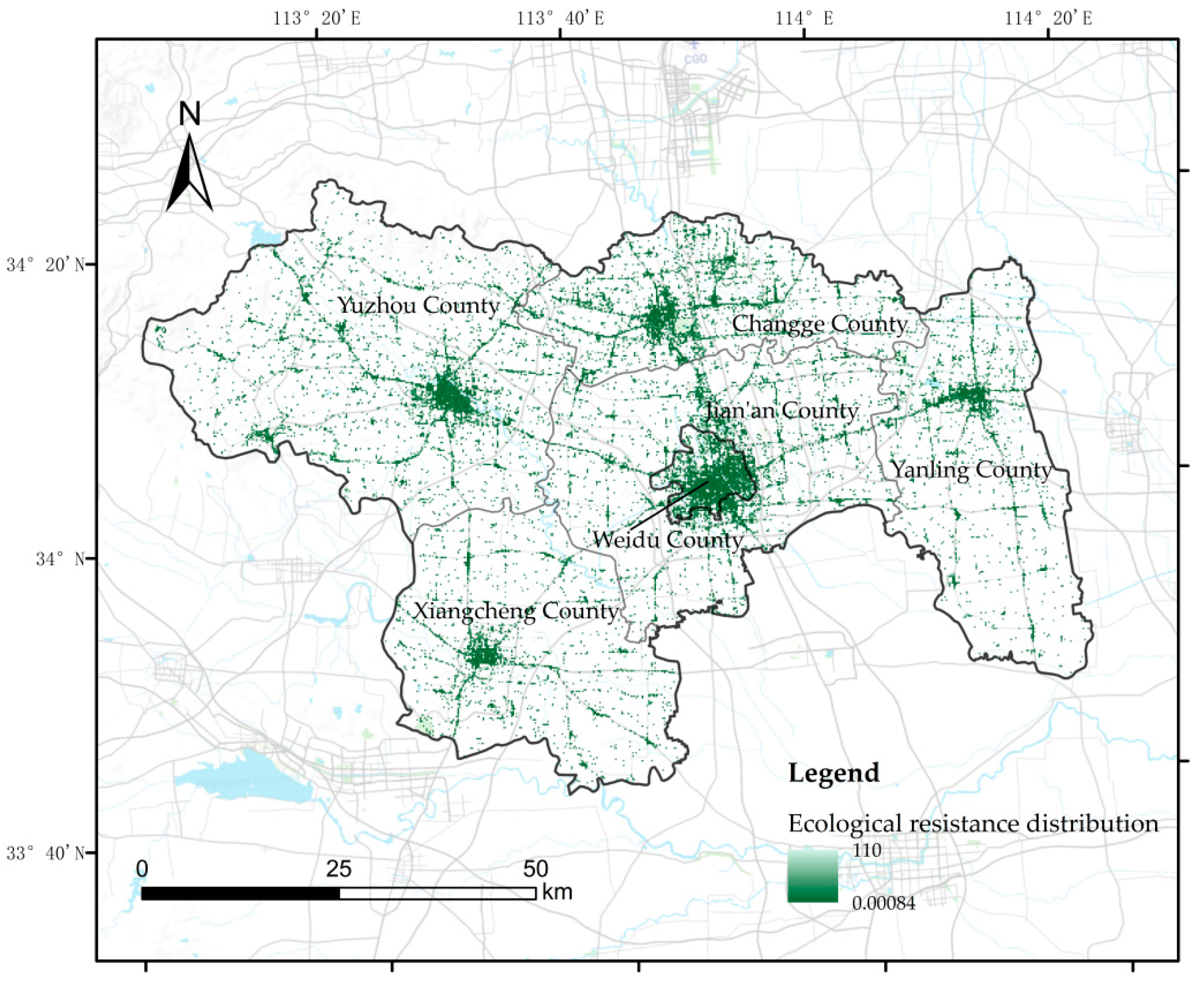



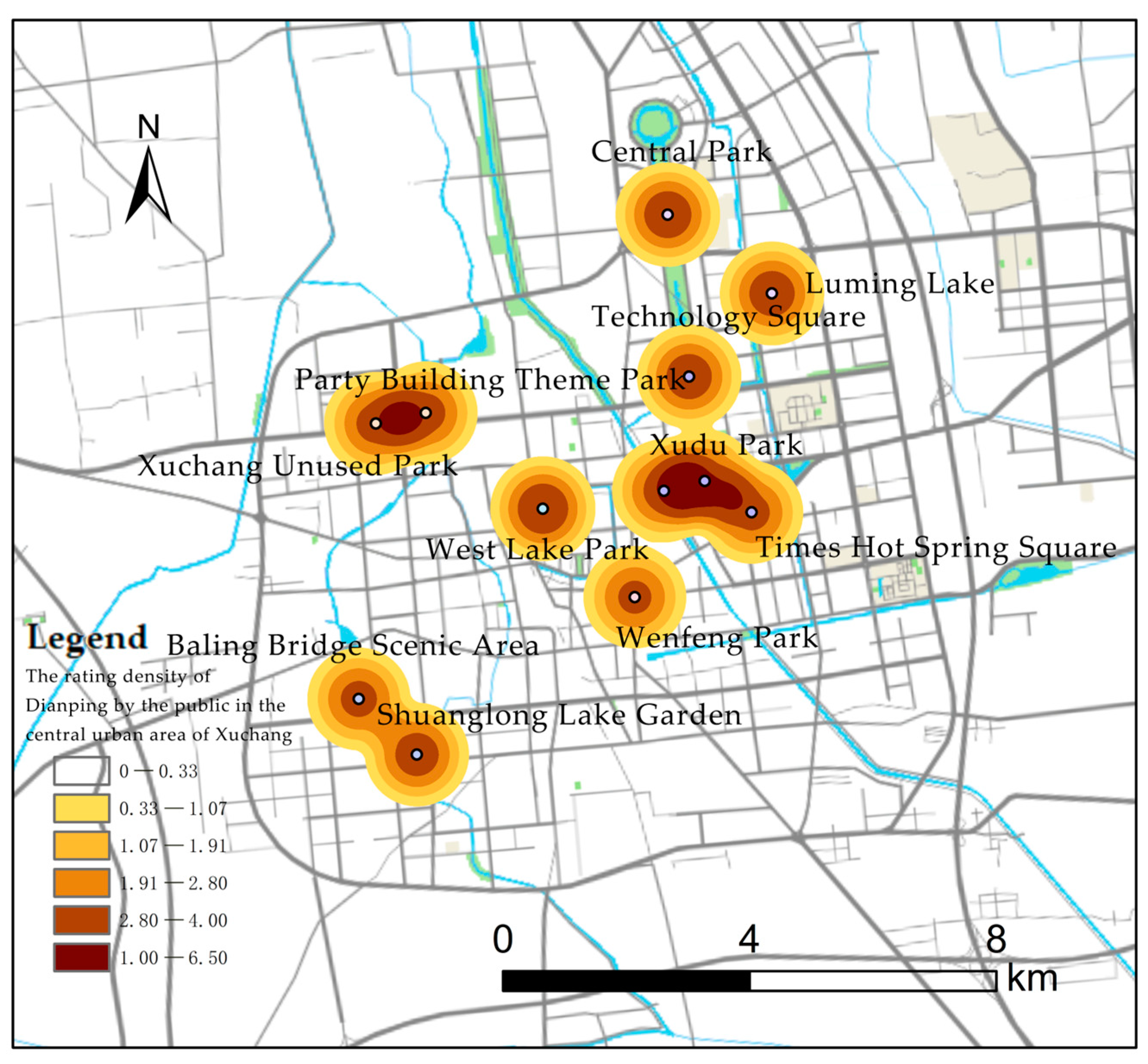


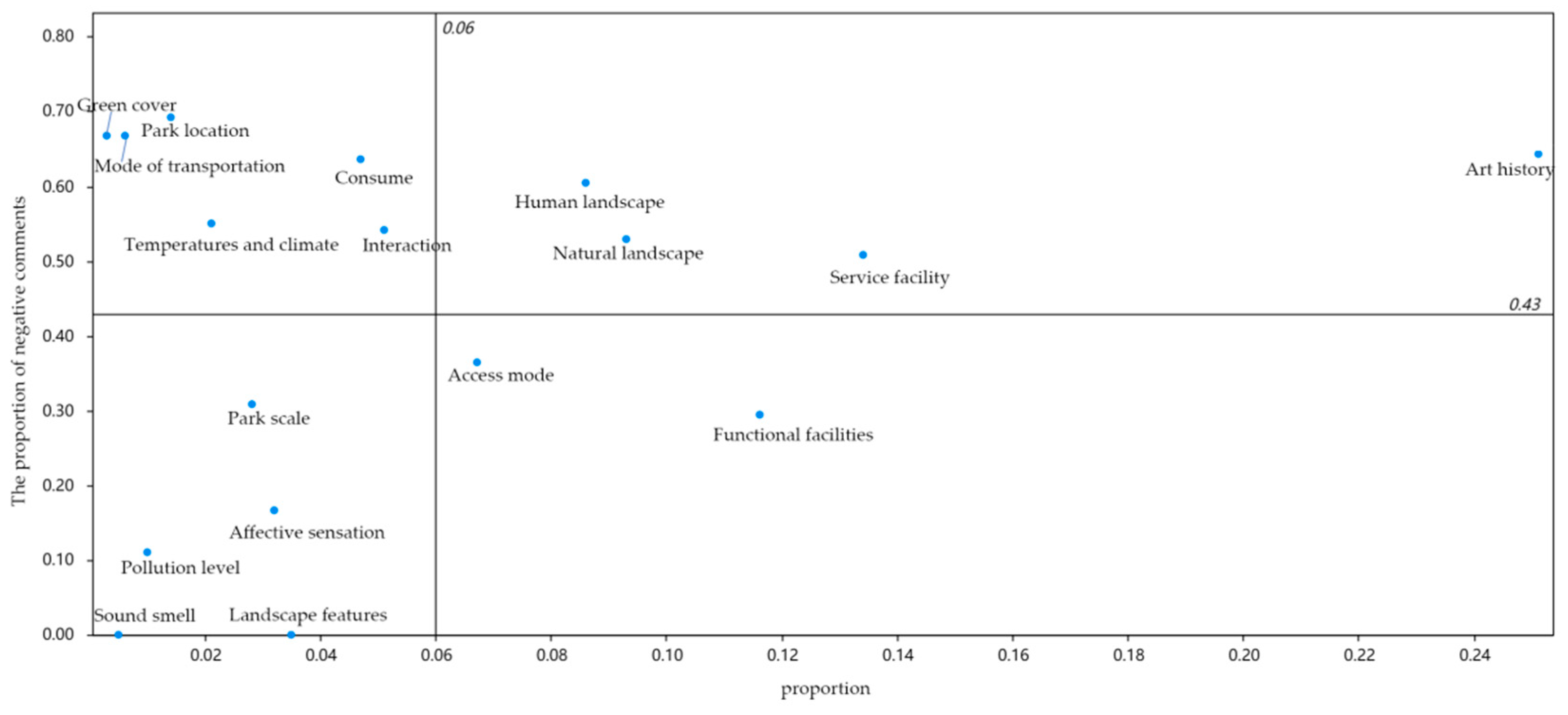
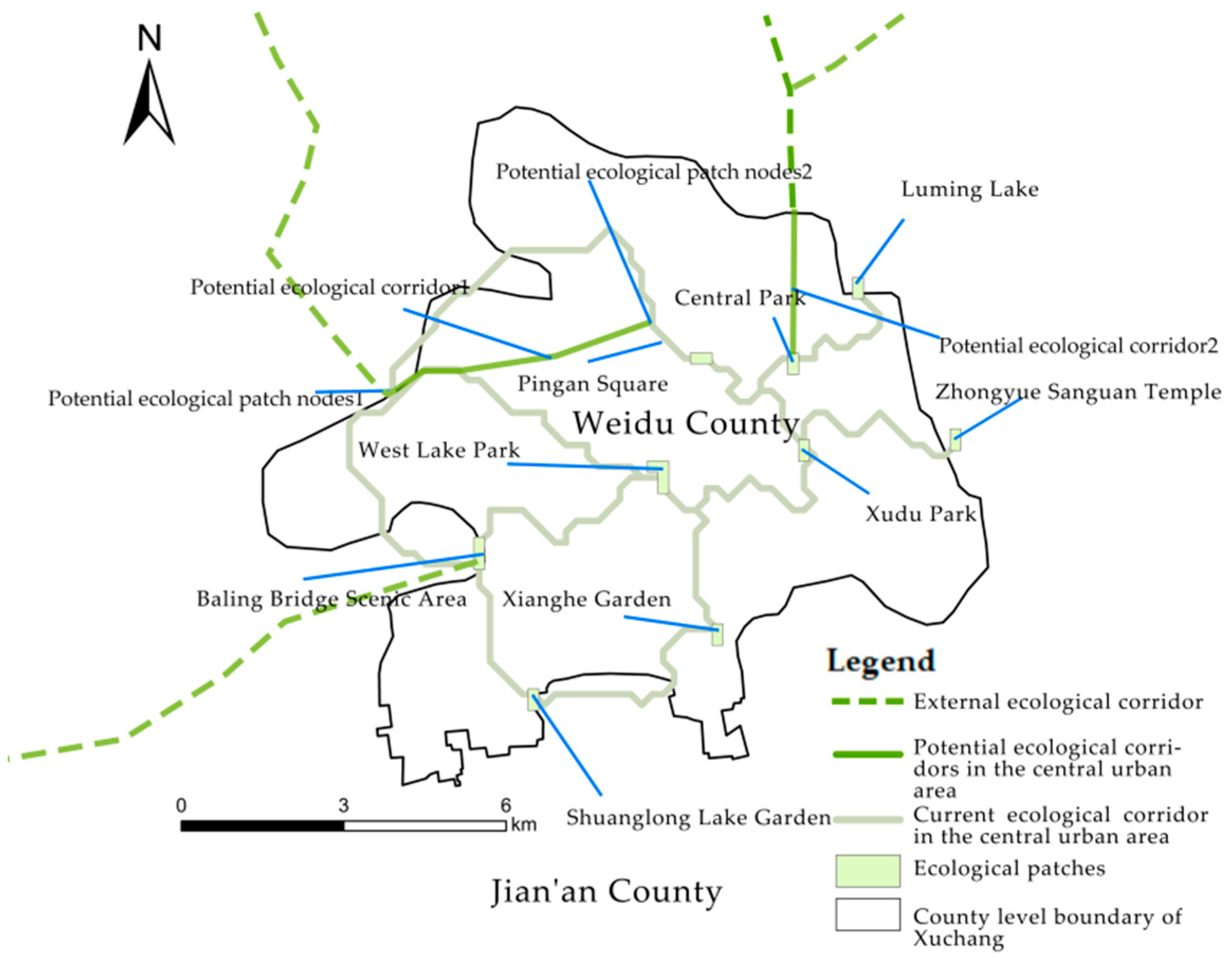
| Space Type | Broad Heading | Class | Degree of Relevance | Relative Area | Comprehensive Weight |
|---|---|---|---|---|---|
| Production space | Insubstantial | Incorporated business | 0.0632 | 0.0082 | 0.0005 |
| Financial insurance | 0.0278 | 0.0082 | 0.0002 | ||
| Government | 0.0072 | 0.1907 | 0.0014 | ||
| Substance | Factory | 0.4259 | 12.8898 | 5.4901 | |
| Logistics | 0.1420 | 12.8898 | 1.8300 | ||
| Transportation | Transportation | 0.3339 | 0.7965 | 0.2660 | |
| Living space | Essential | Catering services | 0.2267 | 0.0584 | 0.0132 |
| Shopping | 0.1447 | 0.0584 | 0.0084 | ||
| Healthcare | 0.1047 | 0.1149 | 0.0120 | ||
| Nonessential | Life services | 0.1047 | 0.0584 | 0.0061 | |
| Science and education culture | 0.0484 | 1.6825 | 0.0814 | ||
| Sports leisure | 0.0668 | 0.2069 | 0.0138 | ||
| Habitancy | Accommodation services | 0.1216 | 3.5220 | 0.4283 | |
| Residential district | 0.1824 | 3.5220 | 0.6424 | ||
| Ecological space | Green area | Famous scenery | 0.2500 | 5.8955 | 1.4739 |
| Park | 0.7500 | 5.8955 | 4.4216 |
| Space Type | Broad Heading | Class | Resistance Value |
|---|---|---|---|
| Production space | Insubstantial | Incorporated business | 37.17 |
| Financial insurance | 48.54 | ||
| Government | 31.15 | ||
| Substance | Factory | 105.26 | |
| Logistics | 99.01 | ||
| Transportation | Transportation | 9.92 | |
| Living space | Essential | Catering services | 66.23 |
| Shopping | 59.88 | ||
| Healthcare | 30.12 | ||
| Nonessential | Life services | 47.39 | |
| Science and education culture | 109.89 | ||
| Sports leisure | 30.21 | ||
| Habitancy | Accommodation services | 68.03 | |
| Residential district | 17.54 | ||
| Ecological space | Green area | Famous scenery | 3.33 |
| Park | 3.33 |
| Ecological Corridor Serial Number | Beginning and End of Ecological Corridor | Ecological Corridor Length/m | Interaction Force |
|---|---|---|---|
| 1 | Xudu Park–Central Park | 2614 | 855 |
| 2 | Shuanglong Lake Garden–Baling Bridge Scenic Area | 3231 | 821 |
| 3 | Xudu Park–Pingan Square | 2980 | 659 |
| 4 | Central Park–Luming Lake | 3097 | 611 |
| 5 | West Lake Park–Baling Bridge Scenic Area | 5063 | 515 |
| 6 | Xianghe Garden–West Lake Park | 3597 | 476 |
| 7 | Xudu Park–Zhongyue Sanguan Temple | 4228 | 356 |
| 8 | West Lake Park–Xudu Park | 5377 | 331 |
| 9 | Shuanglong Lake Garden–Xianghe Garden | 5063 | 156 |
| 10 | Baling Bridge Scenic Area–West Lake Park | 11,774 | 95 |
| 11 | Pingan Square–Baling Bridge Scenic Area | 14,537 | 42 |
| Perceived Dimension | Type of Element | Element Subdivision | Element Content |
|---|---|---|---|
| User dimension | User characteristics | Access mode | Walking, touring, sightseeing, strolling, checking in, relaxing |
| Interaction | Interaction | Story, temple fair, allusion, commemorate | |
| Art history | Guan Yu, Guandi Temple, The Three Kingdoms, Cao Cao, history, Liu Bei, Cao Chong weighs the Elephant, Xudu | ||
| Traffic process dimension | Adjacent degree | Park location | Nearby, four way |
| Mode of transportation | Mode of transportation | Bus | |
| Park dimension | Landscape element | Natural landscape | Water, lake water, Nihe River, lotus, landscape architecture, peony flower, lotus flower, plants, hibiscus, shade trees, ecological landscape, lawn, fish, flowers bloom and willows turn green, a riot of colors, flower Sea, garden, hydrangea flower, Yangliu, osmanthus fragrans |
| Human landscape | Architecture, fountain, statues, Qingshi Bridge, sculpture, pavilion, water curtain, water column, ancient architecture, mural painting, relief sculpture, Wisdom Gate, small bridge flowing water | ||
| Landscape features | Beauty, pretty, beautiful scenery, night view | ||
| Facility elements | Service facility | Square, slide, playground, zoo, museum, parking, basketball court, library, street food | |
| Functional facilities | leisure time, entertainment, amusement, rowing, bodybuilding, physical exercise, morning exercises | ||
| Environmental elements | Temperatures and climate | Comfortable, autumn, overcast, spring, rainy day, accumulated snow | |
| Sound smell | Quiet | ||
| Pollution level | Clean, clear | ||
| Green cover | Green | ||
| Affective sensation | Healthy, beautiful, graceful, ecology, happiness, antique style, beautiful scenery, full of vitality, cheerful | ||
| Scale terrain | Park scale | Very large, small, square meters, wide | |
| Consume | Consume | Free charge |
| Classify | Comment Count | Proportion | Proportion of Negative Comments | Positive Quantity | Negative Quantity |
|---|---|---|---|---|---|
| Access mode | 63 | 6.7% | 36.5% | 40 | 23 |
| Service facility | 126 | 13.4% | 50.8% | 62 | 64 |
| Park scale | 26 | 2.8% | 30.8% | 18 | 8 |
| Park location | 13 | 1.4% | 69.2% | 4 | 9 |
| Functional facilities | 109 | 11.6% | 29.4% | 77 | 32 |
| Interaction | 48 | 5.1% | 54.2% | 22 | 26 |
| Mode of transportation | 6 | 0.6% | 66.7% | 2 | 4 |
| Landscape features | 33 | 3.5% | 0 | 33 | 0 |
| Green cover | 3 | 0.3% | 66.7% | 1 | 2 |
| Temperature and climate | 20 | 2.1% | 55.0% | 9 | 11 |
| Affective sensation | 30 | 3.2% | 16.7% | 25 | 5 |
| Human landscape | 81 | 8.6% | 60.5% | 32 | 49 |
| Art history | 235 | 25.1% | 64.3% | 84 | 151 |
| Sound smell | 5 | 0.5% | 0 | 5 | 0 |
| Pollution level | 9 | 1.0% | 11.1% | 8 | 1 |
| Consume | 44 | 4.7% | 63.6% | 16 | 28 |
| Natural landscape | 87 | 9.3% | 52.9% | 41 | 46 |
Disclaimer/Publisher’s Note: The statements, opinions and data contained in all publications are solely those of the individual author(s) and contributor(s) and not of MDPI and/or the editor(s). MDPI and/or the editor(s) disclaim responsibility for any injury to people or property resulting from any ideas, methods, instructions or products referred to in the content. |
© 2024 by the authors. Published by MDPI on behalf of the International Society for Photogrammetry and Remote Sensing. Licensee MDPI, Basel, Switzerland. This article is an open access article distributed under the terms and conditions of the Creative Commons Attribution (CC BY) license (https://creativecommons.org/licenses/by/4.0/).
Share and Cite
Wei, W.; Wang, S.; Li, X.; Zhou, J.; Zhong, Y.; Li, P.; Zhang, Z. Identification and Analysis of Ecological Corridors in the Central Urban Area of Xuchang Based on Multi-Source Geospatial Data. ISPRS Int. J. Geo-Inf. 2024, 13, 322. https://doi.org/10.3390/ijgi13090322
Wei W, Wang S, Li X, Zhou J, Zhong Y, Li P, Zhang Z. Identification and Analysis of Ecological Corridors in the Central Urban Area of Xuchang Based on Multi-Source Geospatial Data. ISPRS International Journal of Geo-Information. 2024; 13(9):322. https://doi.org/10.3390/ijgi13090322
Chicago/Turabian StyleWei, Wenyu, Shaohua Wang, Xiao Li, Junyuan Zhou, Yang Zhong, Pengze Li, and Zhidong Zhang. 2024. "Identification and Analysis of Ecological Corridors in the Central Urban Area of Xuchang Based on Multi-Source Geospatial Data" ISPRS International Journal of Geo-Information 13, no. 9: 322. https://doi.org/10.3390/ijgi13090322
APA StyleWei, W., Wang, S., Li, X., Zhou, J., Zhong, Y., Li, P., & Zhang, Z. (2024). Identification and Analysis of Ecological Corridors in the Central Urban Area of Xuchang Based on Multi-Source Geospatial Data. ISPRS International Journal of Geo-Information, 13(9), 322. https://doi.org/10.3390/ijgi13090322






